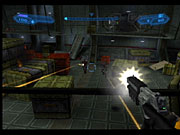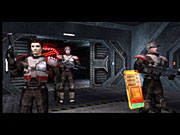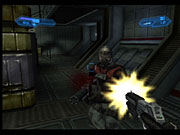Mace Griffin Bounty Hunter is a futuristic sci-fi shooter that diligently follows in the footsteps of the futuristic sci-fi shooters that have come before it. Though it touts a unique blend of standard first-person shooter action and space shooter action, the game continuously evokes either the general feel or specific elements of other recent futuristic sci-fi shooters. Mace Griffin doesn't quite match the level of polish or inspiration found in the games it draws from, but, on its own terms, the game succeeds in providing a straightforward, if somewhat familiar, experience.

The game kicks off with a fairly significant amount of exposition about the future history of the universe and Mace Griffin's specific situation. However, the picture it paints is of a pretty standard futuristic sci-fi universe where corporations squabble over deep-space mining rights and space crime is a constant problem. When we first meet Mace Griffin, the star of the show, he's a part of an elite force of space police called the Rangers, though shortly thereafter he's framed for the slaughter of his squad and quickly sent to space jail. By the time he gets out, the Rangers have been discredited and disbanded, and the only thing on Mace's mind is revenge against those who set him up. He'll need some cash, a ship, and some guns to exact his vengeance, so Mace goes into the bounty-hunting business. As he takes on a series of seemingly unrelated jobs, he begins to learn more and more about the conspiracy responsible for his incarceration and the scale of its nefarious plans. The story elements in the game feel like they're there for the sole purpose of justifying the action, and there's really nothing here that we haven't seen before.

Each of the jobs that Mace takes on is represented by a large and largely self-contained mission. Though the isolated missions give the story a disjointed feel, the actual action is pretty consistent throughout and generally involves the shooting of lots and lots of pretty generic-looking space thugs. The action is pretty good, but it would unquestionably have been better if the AI were more consistent. Sometimes enemies will become aware of your presence before they even see you, rolling behind cover and lobbing grenades, and sometimes you can walk right up and pump a few rounds into them before they'll even acknowledge you. The game helps compensate by placing enemies in hard-to-reach places, and later on by simply giving enemies bigger guns and making them harder to kill, but the kills would've been more satisfying if the enemies were just smarter.
Mace Griffin also falls back on jumping puzzles pretty often--usually where the obvious path is blocked and you're forced to find a trickier alternate route. These can be frustrating at times, partially because the jumping mechanic is a bit rough around the edges, and partially because the visual clues the game gives you can sometimes be a bit unclear. There are also several limited-time sequences, where you're given a countdown clock to play against as you disable a series of bombs, reprogram a ship's navigational computer, or simply try to get to your ship before the rock you're on blows up. The game assists you in reaching your next mission objective by providing you with a compass that is relative to the area you're currently in, but the compass can occasionally be misleading or not relative enough, and sometimes it simply disappears before you've reached your objective.
As mentioned before, each mission is pretty sizeable, with some of the more epic missions taking almost two hours to complete, and aside from the occasional load times, they maintain a constant pace throughout. Save for the somewhat-funky jumping mechanics, the game controls well and addresses the lack of precision you get with playing a first-person shooter on a console by locking on to a target after you have it in your reticle for a set amount of time. This is certainly helpful, but as the game progresses it seems to become less and less reliable. The set of weapons you'll brandish is pretty predictable, including a standard handgun, a sniper rifle, a minigun, a few types of grenades, a rocket launcher, some energy weapons, and a shotgun that looks an awful lot like the standard rifle from Halo. The game also borrows the armor system from Halo, where you can sustain a certain amount of damage before you'll start losing health, and if you stay out of harm's way for a few seconds, your armor will automatically regenerate.
When you're not running around space temples, space mining installations, and space luxury cruisers, you'll be engaging in space dogfights, usually just outside of these ground-based environments. This feature has been one of the game's major selling points since it was first announced, and with this in mind, the space combat sequences in Mace Griffin feel surprisingly tacked-on. These sequences usually come up near the end of a mission, and they generally just require you to take off, shoot some fighters, and then land again. The mechanics of the space combat are simple too, but all told it's still pretty fun and it lends more variety to the gameplay. Still, the space combat doesn't account for a terribly significant portion of the game.

Visually, Mace Griffin Bounty Hunter feels like just about every other futuristic sci-fi first person shooter you've ever played. Other than the game's run-of-the-mill visual style, there's not much to complain about here. The character and level geometry and textures are all technically sound, and there are some other nice touches too. The blurring of the camera when your shield absorbs attacks looks good, as does the tracer effect you see when hit with a concussion grenade, and enemies pour out satisfying gouts of blood when shot. The differences between the Xbox and PlayStation 2 versions of the game are minor and pretty typical of multiplatform ports, with the Xbox version being the superior of the two. On the PS2, the textures suffer from some color banding, the frame rate is less consistent, and the lighting and reflection effects aren't as convincing.
But technical issues aside, much of the game is somewhat generic, from the mining installation that feels as if it were pulled directly out of one of the Red Faction games to Mace Griffin himself, whose smoldering, bent-on-revenge personality just comes across as boring. To be fair, Mace Griffin's presentation isn't entirely derivative, and the game does occasionally show some sparks of originality. The most notable example of this comes up in the second level, which takes place aboard a temple for a futuristic religion that worships technology, and the worshippers all wear masks with flat-panel screens that display an iconic happy face or an iconic frowny face, depending on their mood.

Mace Griffin's sound matches its look pretty well, which is to say that it's satisfactory but lacking in creativity. The weapons sound convincing, from the curt blast of the shotgun to the high-speed whine of the minigun. Various ambient hums and sound effects help flesh out the environments. Oddly, Mace himself doesn't make much noise when jumping, and his footsteps are whisper-quiet, though if you listen closely you can hear him breathing heavily while running. Your enemies have a limited number of phrases they can blurt out during the action, but most of the voice acting is relegated to the in-engine cutscenes. Actor, musician, and spoken-word performer Henry Rollins provides the voice for Mace Griffin, and his performance here is the very definition of "phoning it in." His delivery is consistently low-key and monotone, and instead of sounding like he's grimly serious, he just comes off sounding completely uninterested in the proceedings at hand.
Despite being a rough composite of a half dozen other first-person shooters without much personality of its own, Mace Griffin Bounty Hunter is still pretty good. The action can be fast-paced and engaging, and if you can forgive the game's derivative nature, there's an entertaining experience to be had here.



